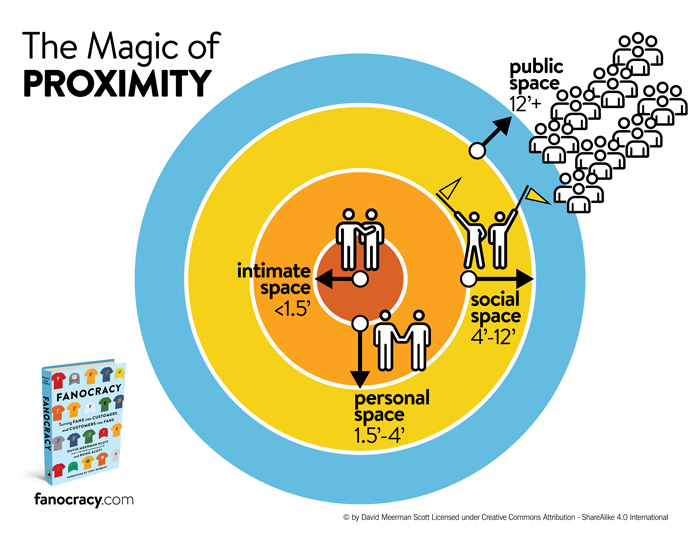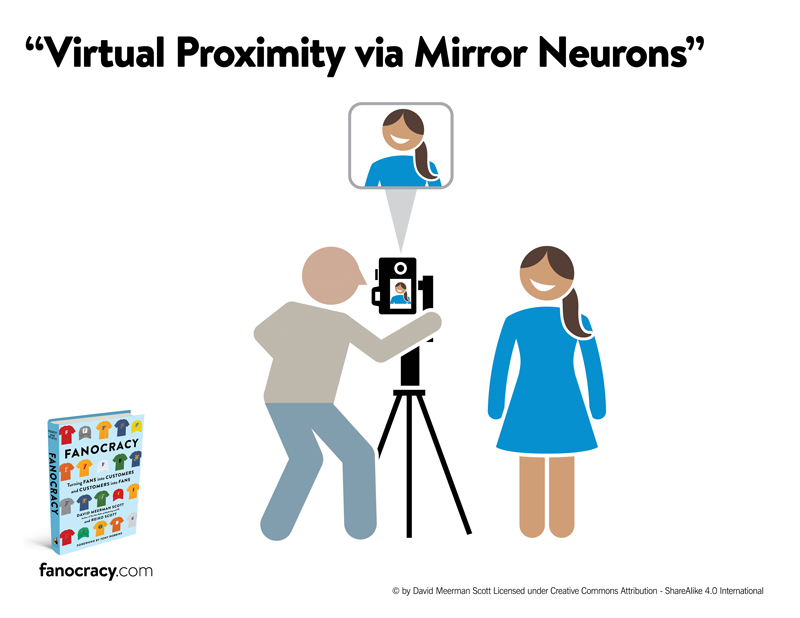Subscribe now and get the latest podcast releases delivered straight to your inbox.
How to use mirror neurons to win fans with your marketing videos

Mar 18, 2020

Editor's Note: Under the global pandemic of COVID-19 or Coronavirus, "social distancing" has become a societal norm. In this environment, we are reminded of just how powerful and essential video has become in maintaining bonds with our audiences and fans as marketers. David Meerman Scott's research was completed before the onset of COVID-19, but it has never been more relevant or insightful. - Ramona Sukhraj, Head of Editorial Content
An understanding of what’s going on in our brains as we watch a video teaches us a simple but powerful way to engage more people and build fans of your videos.
Five years ago, I teamed up with my 27-year-old daughter, Reiko, to research and write our recently published book Fanocracy: Turning Fans into Customers and Customers into Fans. This post on how to build a fandom in your videos using the power of mirror neurons is based in part on the ideas in our book.
I share several fascinating neuroscience concepts as a prescription for creating more effective videos that build fans of your business.
Fandom isn’t just for celebrities anymore! It can be rocket fuel for any business or nonprofit that chooses to focus on inspiring and nurturing true fans.
Over the past several years, Reiko and I spoke with neuroscientists to understand what’s going on in our brains when we connect with other people.
We wanted to know: what’s really happening when, for example, I’m with colleagues at a dinner event?
It turns out physical proximity—a frequently under-appreciated dynamic in our digital age—is an essential ingredient of building fans.

But what is it about being around other people that drives connection? Why does physical proximity make such a difference?
Cultural anthropologist Edward T. Hall has answers to those questions.
As director of the State Department’s Point Four Training Program in the 1950s, Dr. Hall’s mission was to teach foreign country-bound technicians and administrators how to communicate effectively across cultural boundaries.
He defined humans’ use of space in a simple way.
It’s not just a matter of being close or far, or that the closer we get the better it is. Rather, the significance of each level of proximity can be precisely predicted and managed so as to create the most optimal outcomes.
In other words, a situation can be made better or worse by understanding how close we get to one another affects the experience.
If we want to be effective in our communications, we need to learn how to consciously manage this physical space between ourselves and others.
In his 1966 book The Hidden Dimension, Hall describes how people like to keep certain distances between themselves and other people.
For example, he notes “public distance” as more than 12 feet away from others, a distance that lacks any sense of precise interaction among those involved. We experience this when strolling an aisle at the supermarket or on a sidewalk.
Next, he identified “social distance” (which I'm sure many of us are now familiar with) for interactions among acquaintances as being from four feet to 12 feet, “personal distance” for interactions among good friends or family from about a foot and a half to four feet, and anything closer as “intimate distance” for embracing, touching, or whispering.
The degree of human proximity ties to shared emotion and has an enormous effect on how well we do in business.
These behaviors are practically instinctual.
Because these basic instincts are so powerful, when we are close to people we don’t know, like on a subway platform, for example, we’re wary.
We can’t help that response; it’s built into all of us. We’re preparing to flee or to fight if presented with any sign of danger.
When we are in close proximity to people we trust, however, a personal connection develops.
This is something that IMPACT does really well with Digital Sales & Marketing World.
When over 1,000 like-minded professionals are interacting and learning in close physical proximity, a tribe develops.
People naturally feel drawn to other participants as well as IMPACT during those two days.
This is a valuable way for IMPACT to grow fans.
People and brands who cultivate closeness in these ways, bringing customers within a social distance of fewer than 12 feet, or a personal distance of fewer than four feet, create strong emotional bonds and that can create fans.
Unfortunately, physical proximity isn’t always possible.
Creating “virtual” proximity with mirror neurons
So now, you might be thinking, what does physical proximity have to do with videos?
Well, it turns out that our unconscious brain can respond to what we see as if it is our own experience, even if it is just something we see on social media, film, or a video screen.
This is thanks to something called “mirror neurons” and they mean we can use virtual proximity to enhance the power of our videos.
Mirror neurons are a group of cells in the premotor cortex and inferior parietal cortex of our brain.

They are fascinating because they not only activate when we perform an action—biting into an apple, smiling, or getting near to somebody we enjoy being with—they also fire when we observe somebody else performing the same action!
You know how they say laughter is contagious? Mirror neurons are likely why.
When those around us are happy and laughing or smiling, our unconscious brain tells us we’re happy and we often smile too.
Mirror neurons also help explain why we feel that we “know” movie stars and television personalities and why we unconsciously bond with actors and artists and speakers we see on screens and on stage.
Our brain tells us that we’ve been in their personal space because of the feeling of proximity to them as we are seeing them up close on the screen.
This is simply how we’re hardwired.
Mirror neurons are a part of our ancient brain at work helping us to cope with the world around us.
It’s not something we can choose to turn on or choose to ignore. It’s innate. We can’t help but ourselves to react in the way that we do.
The same effects can be applied to marketing videos.
Mirroring to build fans with your video
If you can’t get physically close to your customers, how can you facilitate intimacy with customers through video?
Businesses can use mirror neurons to build fans by paying close attention to camera placement and how they interact with the camera.
You can create virtual proximity in videos by:
- Cropping the video so that the presenter appears to be in the viewer’s personal space. Typically, this means placing the camera about four feet away or using a lens to make it seem that you are that close to the camera.
- Looking directly into the camera as much as possible when you present. This creates the illusion of looking the viewer right in the eye, as you would if you were standing right in front of them.
- Adopting a friendly and open approach by imaging the camera is a close personal friend.
- Having an interesting background in the room where you present. It engages the viewer and invites deeper focus.
- Having someone else film you with a handheld camera. The natural angle that comes with the person’s height and even slight movement of the camera can create a more in-person experience.
With these tips, you can make those who watch your videos feel they are actually in the room with you.
As you’re thinking about the videos you create on a regular basis such as product demonstrations, how-to discussions, customer interviews, and CEO and executive discussions, or even user-generated videos like unboxings, walk-throughs, and testimonials, all these ideas apply.
Consider the importance of mirror neurons when planning your video strategy and execution and you can begin developing more loyal and passionate fans.
Applying this strategy and others in Fanocracy will make your company more likely to dominate your category and win business. Plus, beyond the financial benefits, a fanocracy spreads more joy and inspiration to the world at large!


Order Your Copy of Marcus Sheridan's New Book — Endless Customers!